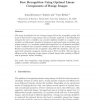Free Online Productivity Tools
i2Speak
i2Symbol
i2OCR
iTex2Img
iWeb2Print
iWeb2Shot
i2Type
iPdf2Split
iPdf2Merge
i2Bopomofo
i2Arabic
i2Style
i2Image
i2PDF
iLatex2Rtf
Sci2ools
135
Voted
IVC
2006
2006
Face recognition using optimal linear components of range images
This paper investigates the use of range images of faces for recognizing people. 3D scans of faces lead to range images that are linearly projected to low-dimensional subspaces for use in a classifier, say a nearest neighbor classifier or a support vector machine, to label people. Learning of subspaces is performed using an optimal component analysis, i.e. a stochastic optimization algorithm (on a Grassmann manifold) to find a subspace that maximizes classifier performance on the training image set. Results are presented for face recognition using FSU face database, and are compared with standard component analysis such as PCA and ICA. This provides an efficient tool for analyzing certain aspects of facial shapes while avoiding a difficult task of geometric surface modeling. Key words: face recognition, range imaging, optimal component analysis, nearest neighbor classifier, Grassmann manifold
Related Content
| Added | 13 Dec 2010 |
| Updated | 13 Dec 2010 |
| Type | Journal |
| Year | 2006 |
| Where | IVC |
| Authors | Anuj Srivastava, Xiuwen Liu, Curt Hesher |
Comments (0)

